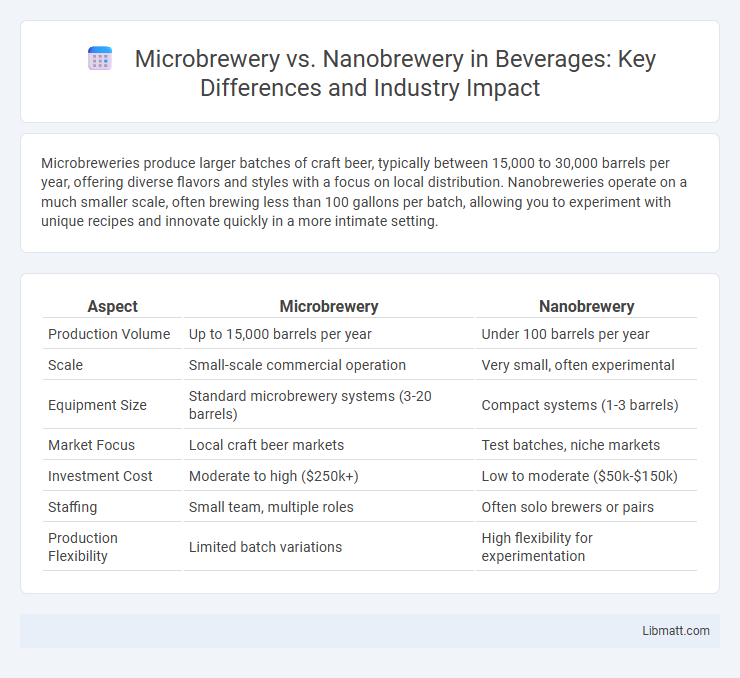Microbreweries produce larger batches of craft beer, typically between 15,000 to 30,000 barrels per year, offering diverse flavors and styles with a focus on local distribution. Nanobreweries operate on a much smaller scale, often brewing less than 100 gallons per batch, allowing you to experiment with unique recipes and innovate quickly in a more intimate setting.
Table of Comparison
| Aspect | Microbrewery | Nanobrewery |
|---|---|---|
| Production Volume | Up to 15,000 barrels per year | Under 100 barrels per year |
| Scale | Small-scale commercial operation | Very small, often experimental |
| Equipment Size | Standard microbrewery systems (3-20 barrels) | Compact systems (1-3 barrels) |
| Market Focus | Local craft beer markets | Test batches, niche markets |
| Investment Cost | Moderate to high ($250k+) | Low to moderate ($50k-$150k) |
| Staffing | Small team, multiple roles | Often solo brewers or pairs |
| Production Flexibility | Limited batch variations | High flexibility for experimentation |
Introduction to Microbreweries and Nanobreweries
Microbreweries typically produce between 15,000 and 30,000 barrels of beer annually, focusing on craft beer with diverse flavors and local ingredients. Nanobreweries operate on a much smaller scale, often producing fewer than 100 barrels per year, emphasizing small-batch experimentation and unique brews. Both brewery types prioritize quality and innovation but differ significantly in production volume and market reach.
Defining Microbrewery: Size and Production
Microbreweries typically produce between 15,000 and 30,000 barrels of beer annually, positioning themselves as small-scale breweries with a strong local presence. Their size allows for a balance of craft quality and commercial distribution, often serving regional markets with a diverse beer portfolio. In contrast, nanobreweries operate on a much smaller scale, usually producing less than 100 barrels per year, focusing on experimental batches and hyper-local sales.
What is a Nanobrewery? Unique Characteristics
A nanobrewery is a small-scale brewery operation that typically produces beer in batches of 1 to 3 barrels or less, focusing on experimental and limited-edition brews. Unique characteristics include minimal production volume, a strong emphasis on craft and innovative flavors, and often a closer connection to local communities due to the intimate size. Unlike microbreweries, nanobreweries prioritize flexibility and niche market appeal over large-scale distribution.
Key Differences: Microbrewery vs Nanobrewery
Microbreweries typically produce between 15,000 to 30,000 barrels of beer annually, while nanobreweries operate on a much smaller scale, producing fewer than 100 barrels per year. Microbreweries often have larger facilities and distribution networks compared to nanobreweries, which focus on experimental, small-batch brews with limited distribution. The key difference lies in production volume, operational scale, and market reach, making microbreweries suited for broader commercial distribution and nanobreweries ideal for local, artisanal craftsmanship.
Brewing Capacity: How Much Beer is Produced?
Microbreweries typically produce between 15,000 and 60,000 barrels of beer annually, offering a balance between craft innovation and commercial scale. Nanobreweries focus on much smaller quantities, often brewing less than 100 barrels per year, ideal for experimental batches and local distribution. Understanding your desired production volume helps determine whether a microbrewery or nanobrewery best fits your brewing goals.
Equipment and Space Requirements
Microbreweries typically require larger, more industrial-grade brewing equipment, including fermenters ranging from 10 to 30 barrels, and expansive space to accommodate storage, packaging, and distribution operations. Nanobreweries, by contrast, utilize compact equipment, often under 3 barrels, designed for small-batch brewing within limited spaces like a garage or small commercial kitchen. The reduced scale of nanobrewery equipment allows for lower initial investment and greater flexibility but limits production capacity compared to microbreweries.
Business Models and Ownership Structures
Microbreweries typically operate on a larger scale with extensive production capacity and often implement complex business models involving multiple distribution channels, while nanobreweries maintain a smaller, more agile setup focusing on local markets and direct customer engagement. Ownership structures in microbreweries frequently include partnerships or investor-backed entities aiming for scalability, whereas nanobreweries are commonly independently owned by single brewers or small teams prioritizing artisanal quality and community connections. Your choice between these models affects investment needs, growth potential, and operational flexibility.
Market Reach and Distribution Strategies
Microbreweries typically have broader market reach and more extensive distribution channels, supplying regional bars, restaurants, and retail stores through established wholesale networks. Nanobreweries, due to smaller production capacity, focus on hyper-local markets, often selling directly to consumers via taprooms, local events, and limited partnerships with neighborhood businesses. Distribution strategies for microbreweries prioritize scalability and brand expansion, while nanobreweries emphasize community engagement and niche market penetration.
Legal Regulations and Licensing Challenges
Microbreweries and nanobreweries face distinct legal regulations and licensing challenges primarily due to their production scales. Microbreweries, producing between 15,000 to 60,000 barrels annually, often navigate more complex federal and state licensing requirements, including tighter labeling laws and distribution restrictions. Your ability to operate a nanobrewery, which typically produces fewer than 100 barrels annually, may benefit from simplified licensing and reduced regulatory fees but still demands compliance with local alcohol control laws.
Which is Right for You: Microbrewery or Nanobrewery?
Choosing between a microbrewery and a nanobrewery depends on your production goals and budget; microbreweries typically produce between 15,000 and 60,000 barrels annually, offering higher output and distribution potential. Nanobreweries focus on smaller batches, often under 100 barrels per year, allowing for greater experimentation and lower startup costs. Assess your target market size, available capital, and desired control over the brewing process to determine which model aligns best with your craft beer business aspirations.
Microbrewery vs nanobrewery Infographic

 libmatt.com
libmatt.com